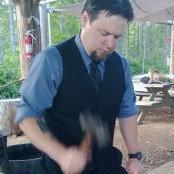I've been a member of IForgeIron.com for a year now, I guess I should start posting!
About me:
At the time of this post, I'm 36 years old, and have been working as a software tester for several years. Smithing is not a profession for me; and though I've been tempted several times to make it into a side business, I've not done so for two major reasons:
1) I still consider myself to be very much a novice.
2) I like being able to treat the craft as a hobby that I indulge in without having to force myself to meet schedules, etc.
I ran my own business once, a motorcycle service/repair business. (I'm a certified motorcycle mechanic). It was very rewarding, but really changed the way I look at motorcycles, and it ended up eating up all my time. It was a success, but extremely hard work keeping on top of all the incoming work orders, making sure customers had their vehicles serviced in a timely manner, etc.
I don't recall why I originally started smithing; I'd learned to weld and do some basic metal shaping, and decided that smithing looked really interesting. I have a number of friends that are into medieval recreation, and I enjoy black powder muzzleloader shooting, so this seemed like a natural hobby to compliment those.
I started out with a homemade coal forge (made from a large truck flywheel with half a truck wheel rim welded to it, on a tripod). I used a small electric squirrel cage blower and some cheap (non-smithing) coal to heat metal. My first anvil was a cheapo cast Harbor Frieght piece of junk.
After a short while I "upgraded" my forge to a homebuilt naturally aspirated propane forge. It's been through a couple of revisions since then, but I get a good heat out of it; I checked it with the pyrometer a couple weeks ago and it was at 2450 Farenheit.
I spent a couple years forging just very casually; about once a month or so, I'd pull everything out and bang on steel. I'm a voracious reader though, and got tons of "book learning" by reading smithing books, and online forums such as Anvilfire.com. Not much hands-on time though.
Last year, I decided to get a little more serious about this and I took a weekend "beginners" workshop from Jerry Culberson at Old Cedar Forge. It was fantastic. Jerry and his helpers (Tri Ficker and Dean Mook) were great about helping me correct errors in my forging habits and I learned a lot in a short time.
(I've got pictures of the weekend workshop here: Blacksmithing Workshop; Old Cedar Forge - a set on Flickr)
After the workshop, I spend every weekend at home, forging away, working on small projects (primarily more tools) and trying to improve my technique.
I volunteered to teach the Metalworking Merit Badge to my son's Boy Scout Troop. We set up a weekend workshop geared to teaching the basics to the boys, and they had a great time.
Here's photos of that event: Boy Scout Troop 53 Blacksmithing - a set on Flickr
That went so well, when the time came for the scouts to go to summer camp for the week, I contacted the camp and arranged to bring my equipment up with me; for that week, I taught metalsmithing to boys from around the district that were attending summer camp: Camping and Blacksmithing at Hahobas Scout Camp 2008 - a set on Flickr
I bought a house in September of last year, so my smithing habits were curtailed until I could get everything moved, unpacked and settled in the new house. I've got everything back up and running now though, and even got the opportunity to make a few things on consignment for a friend.
But the big event will be this summer. I've got enough vacation time saved up from work to be able to take all of July and the first week of August off. I volunteered to use my vacation time to teach smithing at Hahobas Boy Scout camp for all 5 weeks of scout camp. (Troops come up and stay for a week, but there are 5 groups of troops coming trhough over the course of the summer.) Needless to say the camp director and program director were very happy about this, and we are working to setup a good blacksmithing program. Volunteers have already built a large shelter with a metal roof to use for the smithing area. I've got a large coal forge and a bunch of good smithing coal, plus my little homemade coal forge, and of course "Trogdor" (my mighty propane forge) to use this summer.
I'm tempted to find a way to haul my treadle hammer up to camp, but that's probably overkill. I will be bringing my two whetstones though.
Anyway, that's my smithing background in a rather large nutshell.
I'll leave this with a picture of my hammer, anvil, treadle hammer and forge:
Hammer: http://farm3.static.flickr.com/2084/2540944384_e893502536.jpg
Anvil: http://farm3.static.flickr.com/2245/2375686243_6bbb8cd0a1.jpg
Treadle Hammer: http://farm4.static.flickr.com/3170/2834277103_c5756f1225.jpg
Forge: http://farm4.static.flickr.com/3247/2758984080_7607cbee1c.jpg


